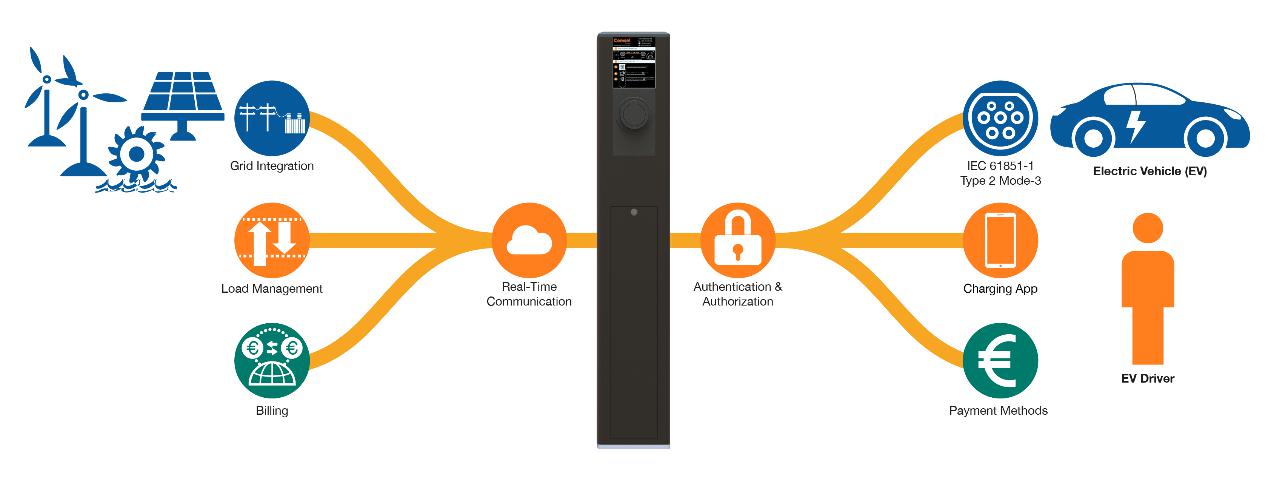 The Electric charging point is similar in function to the tanker inside the gas station. It can be fixed on the ground or wall, installed in public buildings (public buildings, shopping malls, public parking lots, etc.) and residential parking lots or charging stations. It can be based on different voltage levels. Charge all types of electric vehicles.
The Electric charging point is similar in function to the tanker inside the gas station. It can be fixed on the ground or wall, installed in public buildings (public buildings, shopping malls, public parking lots, etc.) and residential parking lots or charging stations. It can be based on different voltage levels. Charge all types of electric vehicles.
We all know the principle of electric vehicle charging, so is the charging principle of electric vehicles the same as electric vehicles? There is also an electric car charging pile divided into AC charging pile and DC charging pile. What is the difference?
First of all, let’s talk about the principle of electric vehicle charging pile:
The charging pile is fixed on the ground, and the special charging interface is used to conduct the alternating electric energy for the electric vehicle with the vehicle charger, and has the corresponding communication, billing and safety protection functions. The public only needs to purchase an IC card and recharge it, so they can use the charging pile to charge the car.
After the electric vehicle battery is discharged, it is returned to the working capacity by direct current through the battery in the opposite direction to the discharge current. This process is called battery charging. When the battery is charged, the positive pole of the battery is connected with the positive pole of the power supply, the negative pole of the battery is connected with the negative pole of the power supply, and the voltage of the charging power supply must be higher than the total electromotive force of the battery.
The difference between DC charging point and AC charging point
DC charging point: DC electric vehicle charging station, commonly known as “fast charging”, it is a power supply device that is fixedly installed outside the electric vehicle and connected to the AC power grid to provide DC power for the non-vehicle electric vehicle power battery.
The input voltage of the DC charging pile adopts three-phase four-wire AC380V±15%, the frequency is 50Hz, and the output is adjustable DC power, which directly charges the power battery of the electric vehicle. Since the DC charging pile is powered by a three-phase four-wire system, it can provide sufficient power, and the output voltage and current adjustment range is large, which can achieve the requirement of fast charging.
AC charging pile: AC electric vehicle charging pile, commonly known as “slow charging”, is fixedly installed outside the electric vehicle and connected to the AC power grid, and provides AC power for the electric vehicle car charger (that is, the charger fixedly mounted on the electric car). Power supply unit.
The AC charging pile only provides power output, and there is no charging function. It is necessary to connect the car charger to charge the electric car. It is equivalent to just playing a role in controlling the power supply.
Summed Up
The difference between the two: Nofuel summed up, AC charging points need to be charged by car charger, DC fast charging pile does not need this equipment. The difference in charging speed between the two is large. It takes 8 hours to fully charge a pure electric vehicle (common battery capacity) through the AC charging pile, and only 2 to 3 hours through the DC fast charging pile.
The AC charging pile provides power input to the electric vehicle’s charger. Since the power of the in-vehicle charger is not large, fast charging cannot be achieved. The DC fast charging pile is a power supply device that is fixedly installed outside the electric vehicle and connected to the AC power grid, and can provide DC power for the power battery of the non-vehicle electric vehicle. The DC charging pile can provide sufficient power, and the output voltage and current adjustment range is large. , can achieve the requirements of fast charge.
Post time: Aug-13-2018
